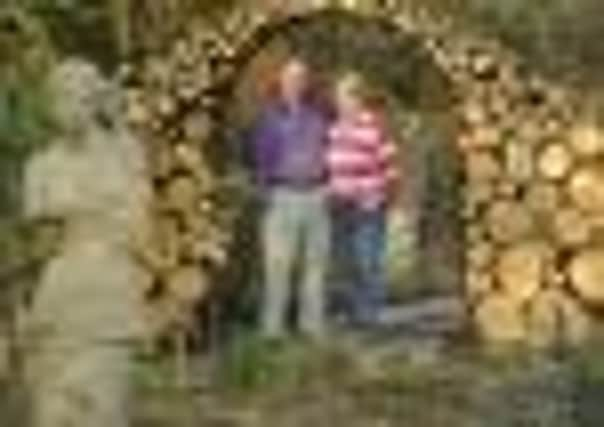Gardens: Enlist a little help in the garden - from the creatures who live there


They set out in the late 1970s as landscape gardeners and for 20 years were based at the Walled Garden at Hopetoun House. For the last ten years they’ve run New Hopetoun Gardens, located west of Edinburgh and their philosophy of only selling plants they believe are really worth growing in your garden still holds true today. This year, the couple are sponsoring the Floral Hall at Gardening Scotland where their own display will focus on the benefits that come from gardening with wildlife in mind.
“Friendly wildlife is always among our top considerations whether in our own garden or when designing gardens for our clients,” says Philip. “We have to take measures to exclude some of the naughty guys like rabbits and deer, but are pretty relaxed about slugs, snails, aphids and so on that provide food for the friendly wildlife we encourage to visit or live in the garden.” He says that many of the priorities clients have on their design wish list are just as beneficial for wildlife as for homeowners. Take year-round interest in the garden, a state of affairs we all dream of. “For wildlife visitors you must ensure a year-round supply of food, avoiding feasts and famine,” says Philip. “So you end up with flowers or berries at every season of the year.” Likewise fragrance in the garden is a common request and as Philip explains: “All gardeners love fragrant plants, but the reason for fragrance is to attract visitors like bees, butterflies and hoverflies to pollinate the plants. The nectar is a reward when they have done their job.”
Advertisement
Hide AdAdvertisement
Hide AdHerbs are one group of plants that please people as much as they please insects and those recommended by Philip and Watson include hardier varieties of lavender such as Hidcote and Mustead, which should be positioned in a sunny, well-drained position and gently clipped at Easter to keep them bushy. Rosemary likes a similar growing position, is great in cooking and provides fragrance and nectar for insects, while evergreen carpets of thyme will be covered in flowers by high summer as well as being frequented by grateful insects. The key things that the plants we choose to grow offer wildlife are nectar, pollen, berries, nesting sites, breeding sites and hibernating sites. If your garden has all this, it should soon be buzzing with life.
Of course not everyone is keen on insect-life – the sight of a wasp can turn even the hardiest gardener’s legs to jelly. “Some folk are fearful of buzzing things, especially if they are allergic to bee stings,” says Philip. “But most other folk can relax about buzzing things if they understand more about them. For instance, wasps are our friends until July. They take aphids back to their nest to feed the queen and get sucrose as a reward. When she stops feeding them in July they get bad tempered and come looking for sweet things from us. Hang up a wasp trap with water and some jam in it, away from you. Hoverflies look like small wasps but are completely harmless and just gobble up aphids in our gardens and pollinate plants for us.”
The potential of wildlife to regulate “pest” issues in the garden shouldn’t be underestimated. Philip says that choosing the right plants is the first step, then disciplining yourself. Laying off the pesticides is essential, in order to give the “good guys time to visit and consume the bad guys”. Ladybirds, for example, will happily help to control aphids and if you can relax enough to leave bare herbaceous plants in place in autumn, the hollow stems will provide hibernation sites for those ladybirds.
One concern about wildlife gardening is that it means an unkempt garden – all patches of nettles and unmown grass. But Philip says that this definitely doesn’t have to be the case. “Wildlife gardens don’t have to be scruffy at all,” he says. “Planting the right plants that are not necessarily wild or even native but are really lovely garden-worthy plants such as buddleias, hebes and lavender will provide food for wildlife and look beautiful at the same time. Certain butterflies will only breed on nettles, but they can just visit your garden to feed, and go to breed in a nettle patch nearby.” He also points out that lawns don’t provide much food for your visitors, unless they are full of clover and daisies for the bees, so you might as well keep the grass cut.
At Gardening Scotland, Philip and Watson plan to show containers full of temporary summer bedding plants that are capable of feeding wildlife visitors all summer. They’ll also be on hand with advice about their star plants for wildlife. Their top ten includes Amelanchier canadensis, a small tree with white blossom in spring and great autumn leaf colour; Erica carnea, a low-growing, winter-flowering heather; and Geranium sanguineum, the bloody cranesbill that reappears every year and flowers for months in the summer. Hebe, lavatera, Sedum spectabile and Buddleia davidii also come highly recommended.
As well as plants, water is a great help for wildlife visitors to your garden. “A birdbath kept full of fresh clean water all year round is invaluable to birds and it’s such good fun to watch them preening themselves,” says Philip. Whatever plants or features you opt for, enjoyment is key. “So long as you have provided yourself with a comfortable seat in the garden and you take the time to use it, it is fascinating watching your wildlife visitors,” says Philip. “Even when the weather isn’t ideal for sitting outside, make sure you can see the bird table, nest box or birdbath from inside and you can enjoy your visitors all year round.”
To find out more about New Hopetoun Gardens, tel: 01506 834433 or visit www.newhopetoungardens.co.uk; Gardening Scotland runs from 1-3 June, visit www.gardeningscotland.com